Trading Journal: How to Track Trades for Consistent, Confident Results
Do you feel like you’re struggling to grow as a trader? Well, don’t worry, you’re not alone. Most traders end up overlooking one of the simplest and most powerful ways to improve their trading results. How? By learning how to track trading performance, which means keeping a trading journal. This might sound simple and maybe ‘useless’, but this is key to your long term success. It is important to understand how tracking improves performance is more than just recording your trades, it’s about transforming your mindset, your behaviour and most importantly, your consistency. But first, what is a trade journal? Let's find out!
- What is a Trade Journal?
- How to Track Trading Performance and How it can help Improve your Trading Experience
- How Tracking Improves Performance: Using a Trading Journal
- How Tracking Improves Performance: Using Technology
- How to Track Trading Performance with Emotional Context
- Conclusion: Journaling & Performance Tracking

What is a Trade Journal?
Let’s start from the very beginning, before we explore how to track trading performance and how tracking improves performance, we need to answer the main question: "what is a trade journal?"
A trading journal is a record you keep of every single trade you take. A good trading journal should include the following:
- The setup
- The reasoning behind your entry
- The emotions you felt during the trade
- The results and outcome
When you use a trading journal, you’re essentially creating feedback for yourself that allows you to learn from your wins and from your losses. The answer to what is a trade journal isn’t just about taking notes, it’s actually a system of self review and structured improvement over periods of time.
How to Track Trading Performance and How it can help Improve your Trading Experience
Too many traders focus only on signals, indicators, or market news, but the real edge comes from knowing yourself. If you really know yourself and if you can write down each trade you’ve placed, you will eventually start to detect patterns, mistakes and strengths in your own behaviour.
Let’s assume you’ve had a streak of losing trades, instead of randomly switching strategies, you should open your trading journal. Analyse your journal and look for patterns. Eventually, you should notice that most losses happened when you broke your own rules or maybe when you traded during low volume hours. Whatever the error points it, that realisation alone could save your next five, ten, twenty trades.
How Tracking Improves Performance: Using a Trading Journal
So, now you know why it’s so important, but how do you actually do it? Here are some basic steps you should start with when tracking your performance:
- Start with the basics: insert the date, the asset, the entry/exit, the stop loss, take profit, and of course, the result
- Record your reasoning: why did you enter this trade? What was the reason behind it?
- Include emotions: during that moment, were you nervous, were you overconfident, or maybe you were unsure? Write it all down so you can reevaluate later
- Evaluate the outcome: did the trade go as you expected? Did you stick to your own rules?
It might seem like a not so critical step, but the truth is, doing this for every single trade will help you understand how tracking improves performance over time.
How Tracking Improves Performance: Using Technology
If you’re not so much the pen on paper type of person and you want to know how to track trading performance easily? Use tools. You can either go old school and use a notebook, or you can go digital with platforms like Notion, Excel, or even trade journaling apps.
Any of the below can be great options for your trading journal, simply choose one that fits your personality better:
- Looking for a beginner friendly tool? Maybe start with Google Sheets
- Perhaps you want automation? You can use platforms that sync with your broker
- Do you prefer structure? You can use a ready made trading journal template from online
- Do you need insights? You can choose tools that analyze your trades with charts and stats
Regardless of the tool you’re using, you still need to enter the right data and knowing what is a trade journal means knowing what to include and what to ignore. But remember, no matter what system you end up using, the key is to review it regularly! Either weekly or monthly review sessions, whatever feels more right, as long as you are really reviewing, you can really discover how tracking improves performance in the long term.
How to Track Trading Performance with Emotional Context
Technical stats tell part of the story, yes, but real breakthroughs happen when you document your mindset. As we know, mindset in trading is everything, so noting down your emotional mindset during your trades can significantly help you in the long run!
Here’s how you can add emotional awareness to your process:
- Rate your confidence before the trade (1–10), were you nervous? Excited? Unsure? Write it all down
- Write what you were thinking or fearing, what thoughts came to mind?
- Reflect on whether you followed your rules, did you miss anything intentionally? If you did, write it down and ask yourself why
This emotional side is too often overlooked, but if you want to really master how to track trading performance, it’s a crucial step in your journaling. In time, you might end up noticing that for example your worst trades happened after a win, when you were feeling overconfident. That’s the kind of insight you would never find on a chart!

Conclusion: Journaling & Performance Tracking
If you’ve made it this far into the course you should have a good understanding of trading journals, why they’re so important, and how they can make the difference between stagnant trading and growth. Let’s sum up everything we’ve learned so far:
What is a Trade Journal?
It’s your personal feedback system, it’s where you write down your trades, your emotions during that trade and your results. It’s a journal you can look back on and reevaluate your trading decisions with, it’s what brings growth and process to serious traders.
How to Track Trading Performance?
Be consistent, write down honest documentation, and look back on it over and over again
How Tracking Improves Performance?
Because it reveals emotional and strategic patterns. Where do you usually go wrong? Do you notice any patterns?
Why is it so important to use a Trading Journal?
Because no external tool will give you the same level of insight as a journal does
Your trading journal is not a luxury, it’s a necessity for anyone serious about long term success in the markets. So if you’re ready to grow as a trader, don’t just study charts, also study yourself.
We hope you enjoyed this course on trading journals and the importance of performance tracking! Are you ready for the next lesson? Keep on reading the EC Markets Academy as we explore the next trading courses, see you there!